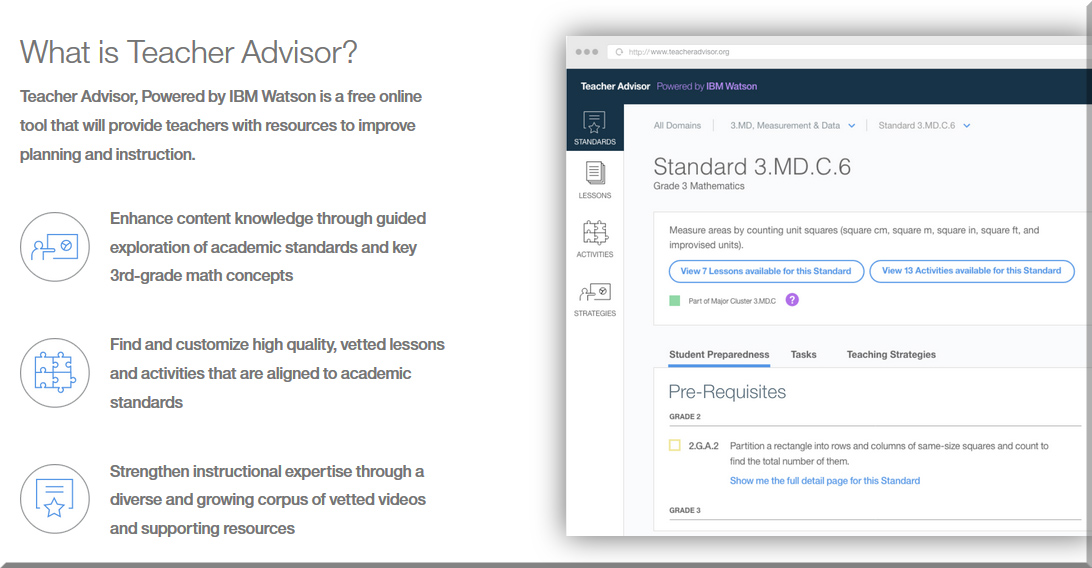IBM Foundation collaborates with AFT and education leaders to use Watson to help teachers — from finance.yahoo.com
Excerpt:
ARMONK, N.Y., Sept. 28, 2016 /PRNewswire/ — Teachers will have access to a new, first-of-its-kind, free tool using IBM’s innovative Watson cognitive technology that has been trained by teachers and designed to strengthen teachers’ instruction and improve student achievement, the IBM Foundation and the American Federation of Teachers announced today.
Hundreds of elementary school teachers across the United States are piloting Teacher Advisor with Watson – an innovative tool by the IBM Foundation that provides teachers with a complete, personalized online resource. Teacher Advisor enables teachers to deepen their knowledge of key math concepts, access high-quality vetted math lessons and acclaimed teaching strategies and gives teachers the unique ability to tailor those lessons to meet their individual classroom needs.
…
Litow said there are plans to make Teacher Advisor available to all elementary school teachers across the U.S. before the end of the year.
In this first phase, Teacher Advisor offers hundreds of high-quality vetted lesson plans, instructional resources, and teaching techniques, which are customized to meet the needs of individual teachers and the particular needs of their students.
Also see:
Educators can also access high-quality videos on teaching techniques to master key skills and bring a lesson or teaching strategy to life into their classroom.
From DSC:
Today’s announcement involved personalization and giving customized directions, and it caused my mind to go in a slightly different direction. (IBM, Google, Microsoft, Apple, Amazon, and others like Smart Sparrow are likely also thinking about this type of direction as well. Perhaps they’re already there…I’m not sure.)
But given the advancements in machine learning/cognitive computing (where example applications include optical character recognition (OCR) and computer vision), how much longer will it be before software is able to remotely or locally “see” what a third grader wrote down for a given math problem (via character and symbol recognition) and “see” what the student’s answer was while checking over the student’s work…if the answer was incorrect, the algorithms will likely know where the student went wrong. The software will be able to ascertain what the student did wrong and then show them how the problem should be solved (either via hints or by showing the entire problem to the student — per the teacher’s instructions/admin settings). Perhaps, via natural language processing, this process could be verbalized as well.
Further questions/thoughts/reflections then came to my mind:
- Will we have bots that teachers can use to teach different subjects? (“Watson may even ask the teacher additional questions to refine its response, honing in on what the teacher needs to address certain challenges.)
- Will we have bots that students can use to get the basics of a given subject/topic/equation?
- Will instructional designers — and/or trainers in the corporate world — need to modify their skillsets to develop these types of bots?
- Will teachers — as well as schools of education in universities and colleges — need to modify their toolboxes and their knowledgebases to take advantage of these sorts of developments?
- How might the corporate world take advantage of these trends and technologies?
- Will MOOCs begin to incorporate these sorts of technologies to aid in personalized learning?
- What sorts of delivery mechanisms could be involved? Will we be tapping into learning-related bots from our living rooms or via our smartphones?
![The Living [Class] Room -- by Daniel Christian -- July 2012 -- a second device used in conjunction with a Smart/Connected TV](http://danielschristian.com/learning-ecosystems/wp-content/uploads/2012/07/The-Living-Class-Room-Daniel-S-Christian-July-2012.jpg)
Also see:
- Next Target for IBM’s Watson? Third-Grade Math — from nytimes.com by Elizabeth Harris
. - IBM Watson will help educators improve teaching skills — from zdnet.com by Natalie Gagliordi
The IBM Foundation has teamed with teachers and the American Federation of Teachers union to create an AI-based lesson plan tool called Teacher Advisor.









